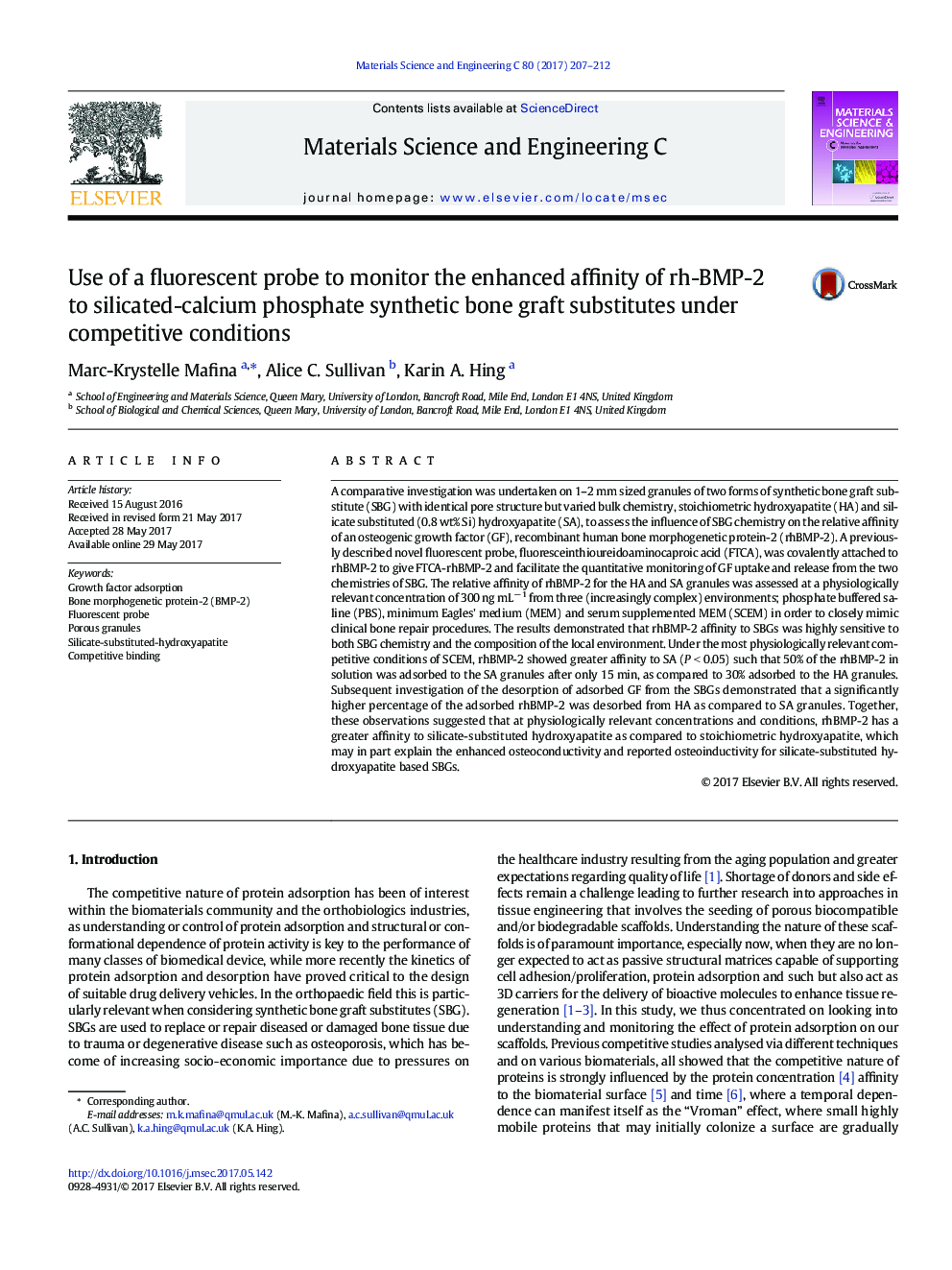| کد مقاله | کد نشریه | سال انتشار | مقاله انگلیسی | نسخه تمام متن |
|---|---|---|---|---|
| 5434313 | 1509141 | 2017 | 6 صفحه PDF | دانلود رایگان |

- A fluorescent label was covalently attached to a growth factor (RhBMP-2) to monitor its adsorption and desorption behaviour on medical devices in a competitive environment.
- RhBMP-2 binding affinity for porous silicate substituted and a stoichiometric hydroxyapatite synthetic bone graft was observed.
- RhBMP-2 at a physiologically relevant concentration of 300Â ngmL-1 was tested in three environments; phosphate buffered saline (PBS), minimum Eagles' medium (MEM) and serum supplemented MEM (SCEM) in order to closely mimic clinical bone repair procedures.
- Observations support the hypothesis that the enhanced bioactivity of these grafts materials may in part be related to their ability to sequester and enrich key adhesion proteins, angiogenic and osteogenic growth factors to confer apparent osteoinductive behaviour on the synthetic scaffolds.
A comparative investigation was undertaken on 1-2 mm sized granules of two forms of synthetic bone graft substitute (SBG) with identical pore structure but varied bulk chemistry, stoichiometric hydroxyapatite (HA) and silicate substituted (0.8 wt% Si) hydroxyapatite (SA), to assess the influence of SBG chemistry on the relative affinity of an osteogenic growth factor (GF), recombinant human bone morphogenetic protein-2 (rhBMP-2). A previously described novel fluorescent probe, fluoresceinthioureidoaminocaproic acid (FTCA), was covalently attached to rhBMP-2 to give FTCA-rhBMP-2 and facilitate the quantitative monitoring of GF uptake and release from the two chemistries of SBG. The relative affinity of rhBMP-2 for the HA and SA granules was assessed at a physiologically relevant concentration of 300 ng mLâ 1 from three (increasingly complex) environments; phosphate buffered saline (PBS), minimum Eagles' medium (MEM) and serum supplemented MEM (SCEM) in order to closely mimic clinical bone repair procedures. The results demonstrated that rhBMP-2 affinity to SBGs was highly sensitive to both SBG chemistry and the composition of the local environment. Under the most physiologically relevant competitive conditions of SCEM, rhBMP-2 showed greater affinity to SA (P < 0.05) such that 50% of the rhBMP-2 in solution was adsorbed to the SA granules after only 15 min, as compared to 30% adsorbed to the HA granules. Subsequent investigation of the desorption of adsorbed GF from the SBGs demonstrated that a significantly higher percentage of the adsorbed rhBMP-2 was desorbed from HA as compared to SA granules. Together, these observations suggested that at physiologically relevant concentrations and conditions, rhBMP-2 has a greater affinity to silicate-substituted hydroxyapatite as compared to stoichiometric hydroxyapatite, which may in part explain the enhanced osteoconductivity and reported osteoinductivity for silicate-substituted hydroxyapatite based SBGs.
SEM image of porous granule of SA SBG gold coated.189
Journal: Materials Science and Engineering: C - Volume 80, 1 November 2017, Pages 207-212